
What does this mean for the effort to grow wages and reduce inequality?
In a new paper, EPI economist and director of the Project on Race, Ethnicity, and the Economy Valerie Wilson projects that people of color will be a majority of the working class by 2032-11 years earlier than the overall U.S. population.
“It is important to realize that the working class is more diverse than stereotypical images of white men in blue collar jobs suggest,” said Wilson. “While policies aimed at raising living standards for the working class are often conflated with policies to raise living standards for white workers without college degrees, the reality is that the working class is increasingly people of color, and our policies should reflect that.”
According to the latest projections from the U.S. Census Bureau, the population of the United States will be “majority-minority” in 2043. For the working-age population, the transition takes place in 2039. Meanwhile, the working class-defined by Wilson as working people without a college degree-will reach this milestone even sooner, based on long-term labor force projections from the Bureau of Labor Statistics and continuation of trends in college completion among different demographic groups. Wilson writes that this transition will have a profound effect on the future of our economic, political, and social infrastructure.
“As people of color become the majority of the working class, economic inequality and racial inequality will likely become more indistinguishable,” said Wilson. “Improving the living standards of working people will necessarily involve bridging racial and ethnic divides and fighting for racial justice.”
Wilson discusses the many implications of this transition, including the possibility that racial resentment and divisions could prevent tomorrow’s working class from achieving the stability and living standards of previous generations. The best way to advance policies to raise living standards for working people is for diverse groups to recognize that they share more in common than not, and work together to achieve their overlapping and intersecting agendas.
Census Bureau Projections:
According to the latest projections from the U.S. Census Bureau, the population of the United States will be “majority-minority”—majority people of color—in 2043. For the working-age population (those between the ages of 18 and 64) the transition takes place in 2039.
The transition to a majority-minority population in 2043 means that although the non-Hispanic white population will remain the largest single group in America, the combined populations of all nonwhite racial and ethnic groups will make up more than half of the U.S. population. The transition is the result of increasing birth rates and net international migration of nonwhites, and the estimated year of its arrival is based on the assumption that current patterns of racial and ethnic self-identification remain constant into the future.
As the current population ages, the older population will remain predominantly non-Hispanic white while the younger population will increasingly be people of color. In 2043, 60.7 percent of people under age 18 will be people of color, while 64.9 percent of those over age 65 will be non-Hispanic white. Given the pervasive impact of race on nearly every aspect of American society, this demographic shift has implications for the future of the American economy, as shaped by the workforce, education, and politics.
While the full realization of a nonwhite majority in the U.S. population is nearly three decades away, there are clear indications that this future reality is quickly taking shape. According to the Census Bureau, the population under age 5 in this country has already reached this milestone, a fact that is reflected in the demographic composition of public schools.





